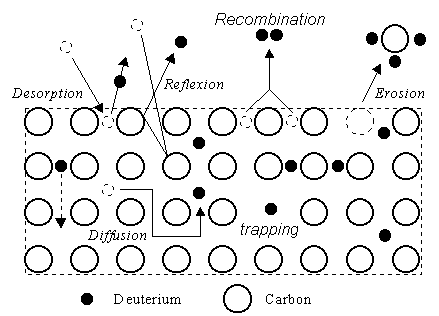|
5) Plasma-wall interaction and particles and heat extraction
(p 1 -
2
- 3 - 4
-
5 - 6 -
7 )
| What happens when the plasma interacts with the wall? Let us take another look, this time from the point of view of the wall. |
f) And the wall in all this?
What happens when the plasma interacts with a solid wall ? Let us take the case where the wall is made of carbon, a very common material in tokamaks on account of its resistance to thermal shocks, and the incidental particle a D+ Deuterium ion. A number of phenomena may take place.
First of all, the incidental charged particle may simply be reflected in the form of a neutral particle (D atom
or D2 molecule in the case of recombination) and go back to the plasma, where it will once again be ionised. This is recycling.
Subsequently, the particle may be absorbed by the wall, as carbon acts like a sponge for hydrogen. This goes on until the carbon is saturated with hydrogen, just as a sponge may only absorb a certain amount of water. Under certain conditions (overheating for example), the wall may also release particles that it has trapped, like a sponge being squeezed. The
incident particles may also by impact free trapped particles (desorption).
All this complicates the control of the plasma density, which may be strongly influenced by the state of saturation of the wall, a huge reservoir of particles with a very long filling duration. This was clearly seen on Tore Supra, in particular in the long pulse programme, where
the plasma density tends to rise at the end of the pulse, probably on account of gas emission from
a far-away wall, which is not concerned in shorter pulses but heats up over time. The solution is cooling down all wall components, even those further away from the plasma. This is what was done on Tore Supra in the framework of the CIEL project.
|
|

|
Tokamak conditioning
In addition, we are also developing conditioning
 techniques of the vacuum chamber, in order to better control the wall status. The first procedure consists in covering the walls with a very fine protective coating with special properties. In Tore Supra, we periodically (around once a month) carry out a boronisation procedure (film in boron carbide), which has in addition the advantage of being an oxygen trap
thus enhancing plasma purity. Between two boronisations, we can also desaturate the wall with glow
discharge (i.e. we create a very low power helium plasma without the confinement field, which cleans the walls and gets out the deuterium trapped by impact of helium particles on the wall). This is carried out at night to prepare the experimental programme for the next day. Finally,
during an experimental day, we have set up conditioning discharges so as to help recover some
of the trapped particles and operate with a wall that is more or less de-saturated, even after a number of
discharges or a disruption.
techniques of the vacuum chamber, in order to better control the wall status. The first procedure consists in covering the walls with a very fine protective coating with special properties. In Tore Supra, we periodically (around once a month) carry out a boronisation procedure (film in boron carbide), which has in addition the advantage of being an oxygen trap
thus enhancing plasma purity. Between two boronisations, we can also desaturate the wall with glow
discharge (i.e. we create a very low power helium plasma without the confinement field, which cleans the walls and gets out the deuterium trapped by impact of helium particles on the wall). This is carried out at night to prepare the experimental programme for the next day. Finally,
during an experimental day, we have set up conditioning discharges so as to help recover some
of the trapped particles and operate with a wall that is more or less de-saturated, even after a number of
discharges or a disruption.
Apart from the control of plasma density, another
important question is the hydrogen retention in the wall, which will become problematic when we use radioactive tritium as fuel in the next step. From the results of the tokamaks JET
 and TFTR, the only machines to have used tritium up to now, we are elaborating scenarios that will minimise retention in the wall, as well as conditioning techniques to recover trapped tritium.
and TFTR, the only machines to have used tritium up to now, we are elaborating scenarios that will minimise retention in the wall, as well as conditioning techniques to recover trapped tritium.
Finally, the
incident particles may tear out carbon atoms from the wall, a process that is known as erosion. Some of these
impurity atoms may then, as a result of a several atomic physical phenomena, get through to the centre of the
discharges and damage the central plasma performance by radiating part of the power coupled to the plasma. After complex transport phenomena, the eroded carbon may be deposited on the walls of the machine, sometimes quite a long away from the place
it was eroded from. But this replacement is not enough to prevent slow erosion of plasma facing components, in particular in places where there is a concentration of
incidental particle flux: this is one of the main preoccupations for next generation machines, where the components must be ensured a sufficiently long lifetime to not have to be changed too frequently. Many studies are being carried out, as much from the wall point of view (doped
materials to better withstand erosion, use of tungsten or of beryllium instead of carbon) as from the plasma point of view (attenuation of incidental
flux in radiative scenarios).
|
|